7 results
Astronomy study guides for Easel
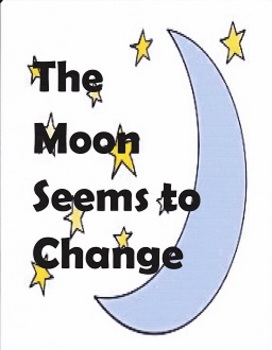
The Moon Seems to Change: Imagine It - Grade 3
Supplemental activities for Imagine It, Grade 3, Unit 4 Lesson 3: The Moon Seems to Change. This study guide includes a list of spelling words to go home, vocabulary,and comprehension activities. The extensions will give students the opportunity to use higher level thinking skills - Revised Bloom's Taxonomy.
Common Core objectives:
R.L.: 3.2, 3.6, 3.7, 3.9, 3.10
R.I.: 3.1, 3.6, 3.7, 3.9, 3.10
L.: 3.2, 3.4, 3.5
Grades:
2nd - 4th
Types:
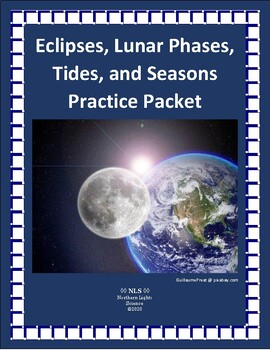
Eclipses, Lunar Phases, Tides, and Seasons Practice Packet
This must-have packet will reinforce middle school science students’ understanding of Earth’s seasons, the tides, eclipses, and the lunar phases.Students will perform the following tasks in this lesson.Sketch a few select lunar phases.Draw and label the moon's position in relation to Earth and the sun during a solar eclipse.Draw and label the moon's position in relation to Earth and the sun during a lunar eclipse.Draw and label the umbra and penumbra for both eclipses.Differentiate waxing from w
Subjects:
Grades:
6th - 9th
Types:
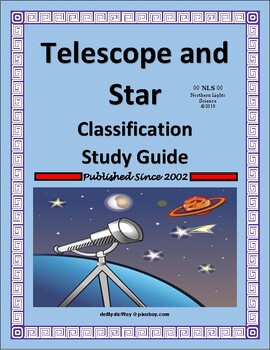
Telescope and Star Classification Study Guide with a Key
Welcome! This listing features a full-page study guide about the tools of astronomy and star classification. In this activity, students will perform the following tasks.Explain the relationship between the visible light a star emits and electromagnetic radiationIdentify which color has the longer wavelengthCite three examples of the visible light spectrum other than visible lightState what refracting, reflecting and radio telescopes have in common in how they functionIdentify the most ideal geog
Subjects:
Grades:
7th - 9th
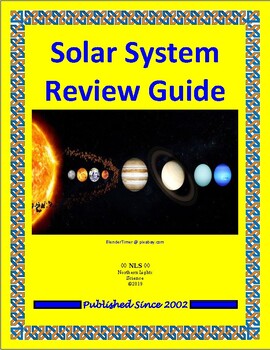
Solar System Review Guide
Greetings! Middle school science students will complete the following tasks for this full-page activity.Make surface and atmospheric comparisons between the terrestrial planets and the Jovian planets (gas giants)Rank the terrestrial plants by atmospheric density and temperatureCompare and contrast the sun surface features (prominence, sunspot, and solar flare)Compare and distinguish the galactic objects by filling in a flow chart and answering short answer questions (comets, asteroids, meteoroid
Subjects:
Grades:
6th - 8th
Types:
Also included in: TpT Digital/Easel-Ready Middle School Science Solar System Mini Unit

Star Life Cycle Cryptogram Puzzle Activity
This listing features a fun cryptogram about the life cycle of stars. A cryptogram is a type of puzzle with an encrypted text. In this cryptogram, students will decipher a number code to reveal the letters to form a summary statement text about a star's life cycle. The header on both of the student pages has a horizontal letter-number assignment table. Students start out the activity knowing the number assignments for six letters. The entire message appears as a series of blank lines grouped int
Subjects:
Grades:
6th - 9th
Types:
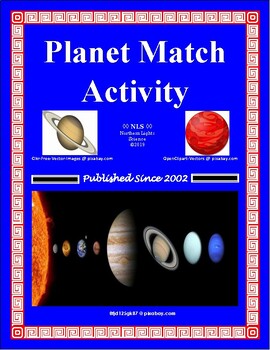
Planet Match Activity
This listing features a full-page activity where students match the eight planets in our solar system to thirty-one numbered descriptions. Students will then write the names of the planets on the blank lines next to the appropriate description. I provided a planet word bank in a text box in the upper left corner of the front page of the student answer sheet to assist students with spelling difficulties. Each numbered description highlights one to two features of the targeted planet. The quantita
Subjects:
Grades:
6th - 9th
Types:
Also included in: TpT Digital/Easel-Ready Middle School Science Solar System Mini Unit
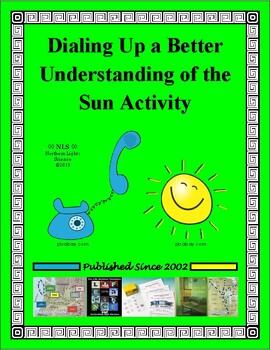
Dialing up a Better Understanding of the Sun Activity (Sun Worksheet)
Greetings! This listing features a full-page study guide about the sun for middle school astronomy or space science. This learning resource offers seven sections bulleted below in detail.An opening table where students match the names of four key ancient scientists and/or mathematicians with their contributions in the field of astronomy in a table – Kepler, Copernicus, Galileo, and Newton.A large Venn diagram where students compare Earth to the sun with the assistance of a word/phrase bankAn opp
Subjects:
Grades:
6th - 8th
Types:
Also included in: TpT Digital/Easel-Ready Middle School Science Solar System Mini Unit
Showing 1-7 of 7 results





